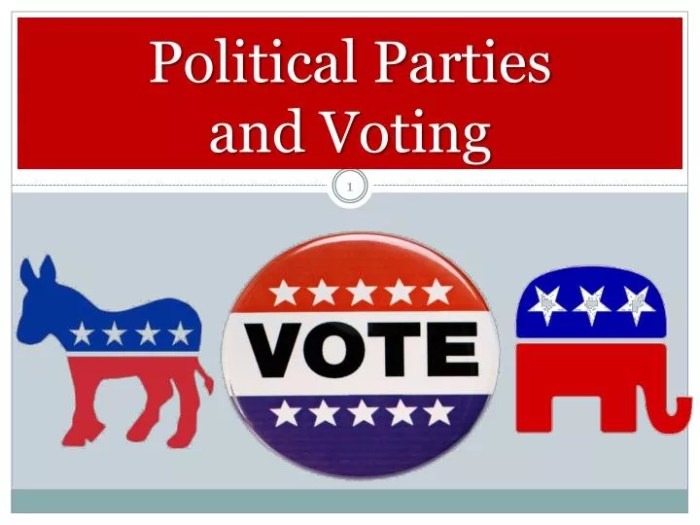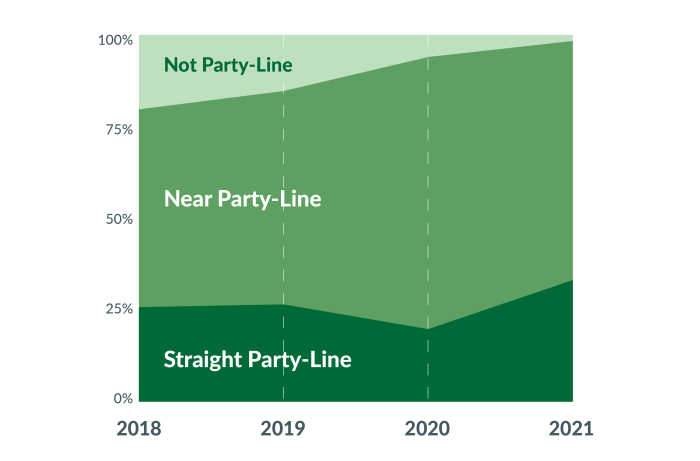Party line voting definition ap gov delves into the intricacies of a political phenomenon that shapes legislative outcomes, party dynamics, and the broader political landscape. This comprehensive analysis explores the concept, factors influencing it, historical examples, current trends, and ethical considerations, providing a nuanced understanding of this pivotal aspect of modern governance.
Party line voting refers to the practice of legislators voting in accordance with their party’s official stance on a particular issue, regardless of their personal views or constituent preferences. This practice has significant implications for party cohesion, legislative efficiency, and the representation of diverse perspectives within the political system.
Definition of Party Line Voting: Party Line Voting Definition Ap Gov

Party line voting refers to the practice of legislators voting in accordance with the official position of their political party, regardless of their personal beliefs or the preferences of their constituents. It is a common practice in many parliamentary systems, where party discipline is strong and individual legislators have limited autonomy.
Examples of party line voting include:
- In the United States, members of the Republican and Democratic parties often vote along party lines on major legislation.
- In the United Kingdom, members of the Conservative and Labour parties typically vote with their party on most issues.
Factors Influencing Party Line Voting
Party loyalty is a major factor influencing party line voting. Legislators who are strongly loyal to their party are more likely to vote with their party, even if they disagree with the party’s position.
Other factors that can influence party line voting include:
- Ideology:Legislators who share the same ideology as their party are more likely to vote with their party.
- Constituent preferences:Legislators who represent constituencies with strong partisan preferences are more likely to vote with their party.
- Party leadership:Party leaders can influence party line voting by setting the party’s agenda and enforcing party discipline.
Consequences of Party Line Voting
Party line voting can have both positive and negative consequences.
Positive consequences include:
- Increased party cohesion:Party line voting helps to create a sense of unity and purpose within political parties.
- Increased efficiency:Party line voting can help to speed up the legislative process by reducing the need for debate and compromise.
Negative consequences include:
- Reduced individual legislator autonomy:Party line voting can reduce the autonomy of individual legislators, making them less responsive to the needs of their constituents.
- Increased polarization:Party line voting can contribute to political polarization, as legislators become more entrenched in their party positions.
Historical Examples of Party Line Voting, Party line voting definition ap gov
Party line voting has been a common practice in the United States since the early days of the republic. Some notable examples of party line voting in American history include:
- The passage of the Civil Rights Act of 1964, which was supported by nearly all Democrats and opposed by nearly all Republicans.
- The impeachment of Bill Clinton, which was supported by nearly all Republicans and opposed by nearly all Democrats.
Current Trends in Party Line Voting
Party line voting has become increasingly common in the United States in recent years. This trend is due in part to the rise of partisan media, which has made it more difficult for legislators to compromise with members of the opposite party.
The implications of this trend are significant. Increased party line voting could lead to further political polarization and gridlock in Congress.
Comparative Analysis of Party Line Voting
Party line voting is a common practice in many parliamentary systems around the world. However, the extent to which party line voting occurs varies from country to country.
In some countries, such as the United Kingdom, party line voting is very common. In other countries, such as the United States, party line voting is less common.
The factors that influence party line voting vary from country to country. In some countries, party loyalty is a major factor, while in other countries, ideology is a more important factor.
Impact of Party Line Voting on Policy Outcomes
Party line voting can have a significant impact on policy outcomes. When legislators vote along party lines, it is more difficult to pass legislation that is supported by a majority of the public.
For example, in the United States, the Affordable Care Act was passed in 2010 with the support of all Democrats and no Republicans. This made it difficult to repeal the law, even though it was unpopular with many Americans.
Ethical Considerations of Party Line Voting
Party line voting raises a number of ethical concerns. One concern is that it can lead to legislators voting against their own beliefs. Another concern is that it can reduce the accountability of legislators to their constituents.
However, some argue that party line voting is necessary to maintain party discipline and to ensure that the party’s agenda is implemented.
Common Queries
What are the key factors that influence party line voting?
Party loyalty, ideology, constituent preferences, and party leadership are among the primary factors that shape legislators’ decisions to vote in line with their party’s stance.
What are the potential benefits of party line voting?
Increased party cohesion, legislative efficiency, and a clearer mandate for the governing party are some of the potential advantages of party line voting.
What are the potential drawbacks of party line voting?
Reduced individual legislator autonomy, polarization, and the suppression of diverse perspectives are some of the potential disadvantages associated with party line voting.

